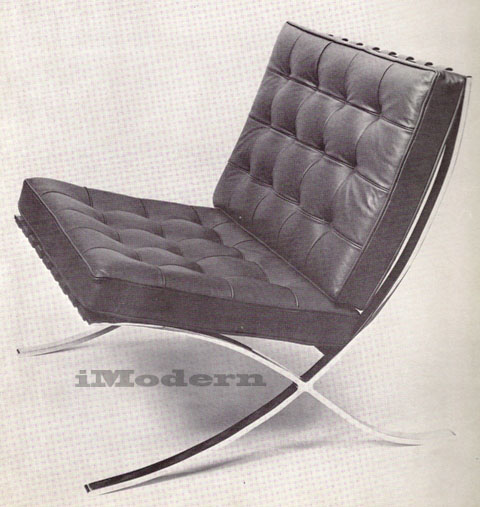Barcelona chair by Mies van der Rohe
Germany, 1929

This chair was designed by Mies van der Rohe for the German Government pavilion, which he designed
for the Barcelona International Exhibition of 1929.
The brief was to design a chair fit to receive a king, a dictator or an ambassador. It was designed
to be a very important chair. The design succeeds in matching and conferring dignity. The Barcelona is
elegant, costly and monumental.
The amount of hand work required in the making of this chair is staggering. The upholstery is
composed of forty separately cut panels joined by narrow hand-sewn welts; the leather straps are held on by
seventy-two screws each tapped and screwed into the metal frame through the ends of the straps; the stainless steel
frame is all electric arc welded, hand finished, and polished to a perfect mirror finish.
Apart from some machine sewing and the extruded-steel sections the chair is almost entirely
hand-made, which explains its high purchase price. In spite of all this, the finished chair could never be said to
emphasize, nor even to reveal its own production methods, nor has it any trace of 'handmade by craftsmen'
connotations.
There have been several modifications in the production since the original design. The chromed
steel has been replaced by polished stainless steel, and the cotton, burlap and horsehair filling of the upholstery
has been superseded by foam rubber. This has resulted in an even more long lasting chair, with virtually nothing to
wear out.
The Barcelona is a fine chair, and has a marvelously generous scale. The solid metal section of the
double X shaped frame makes it a very heavy chair, a fact belied by the visual effect of its beautiful formal
balance.
Mies van der Hohe's approach here has been likened to gothic architecture, with its cathedral-like
skeletons of exposed, flowing, linear structures. In his own architecture, however, the structure is purely
rectilinear, but the details are worked out with a finesse that is indeed comparable to gothic stone detailing.
(This is particularly apparent in buildings such as Farnworth House, Crown Hall, the Institute of Technology of
Chicago, and the new National Gallery of Berlin.)
The Barcelona chair is at its best in an open space where it can be appreciated from a distance
away or where it can be seen from a low angle.
Basculant by Le Corbusier
| 